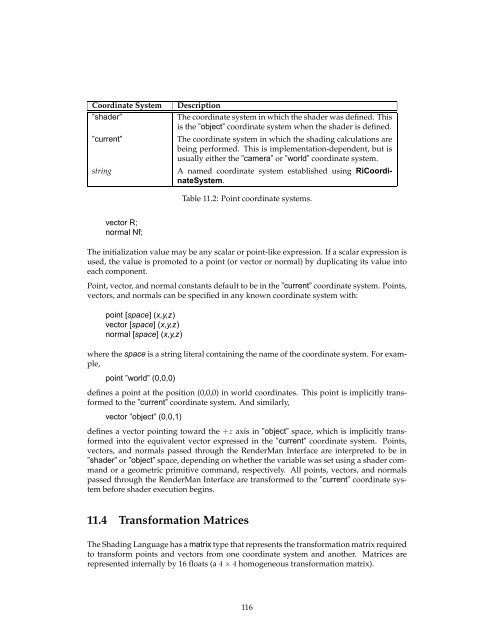The RenderMan Interface - Paul Bourke
The RenderMan Interface - Paul Bourke
The RenderMan Interface - Paul Bourke
- No tags were found...
Create successful ePaper yourself
Turn your PDF publications into a flip-book with our unique Google optimized e-Paper software.
Coordinate System<br />
”shader”<br />
”current”<br />
string<br />
Description<br />
<strong>The</strong> coordinate system in which the shader was defined. This<br />
is the ”object” coordinate system when the shader is defined.<br />
<strong>The</strong> coordinate system in which the shading calculations are<br />
being performed. This is implementation-dependent, but is<br />
usually either the ”camera” or ”world” coordinate system.<br />
A named coordinate system established using RiCoordinateSystem.<br />
Table 11.2: Point coordinate systems.<br />
vector R;<br />
normal Nf;<br />
<strong>The</strong> initialization value may be any scalar or point-like expression. If a scalar expression is<br />
used, the value is promoted to a point (or vector or normal) by duplicating its value into<br />
each component.<br />
Point, vector, and normal constants default to be in the ”current” coordinate system. Points,<br />
vectors, and normals can be specified in any known coordinate system with:<br />
point [space] (x,y,z)<br />
vector [space] (x,y,z)<br />
normal [space] (x,y,z)<br />
where the space is a string literal containing the name of the coordinate system. For example,<br />
point ”world” (0,0,0)<br />
defines a point at the position (0,0,0) in world coordinates. This point is implicitly transformed<br />
to the ”current” coordinate system. And similarly,<br />
vector ”object” (0,0,1)<br />
defines a vector pointing toward the +z axis in ”object” space, which is implicitly transformed<br />
into the equivalent vector expressed in the ”current” coordinate system. Points,<br />
vectors, and normals passed through the <strong>RenderMan</strong> <strong>Interface</strong> are interpreted to be in<br />
”shader” or ”object” space, depending on whether the variable was set using a shader command<br />
or a geometric primitive command, respectively. All points, vectors, and normals<br />
passed through the <strong>RenderMan</strong> <strong>Interface</strong> are transformed to the ”current” coordinate system<br />
before shader execution begins.<br />
11.4 Transformation Matrices<br />
<strong>The</strong> Shading Language has a matrix type that represents the transformation matrix required<br />
to transform points and vectors from one coordinate system and another. Matrices are<br />
represented internally by 16 floats (a 4 × 4 homogeneous transformation matrix).<br />
116















